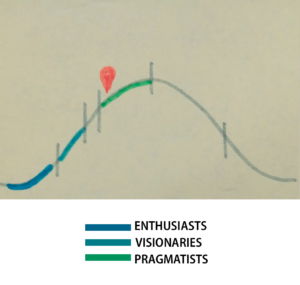I think no one doubts anymore that the corporate world is really starting to make the most of agility. We’re on the crest of the wave of an adoption curve.
The pragmatic can see that being agile means delivering value and achieving success in their businesses, and there is heavy investment in agility across the market.

When we talk about agility, our first impulse is to put together a team, run learning cycles (with or without explicit sprints), define the roles of who’s creating the product, or executing the service… And very often we leave aside the role of manager from all this.
The ground starts shifting from under his feet and he hears things like “You mustn’t micromanage the team!”, “You’re not the one who gives feedback, it’s those with the problem!”, “The team is self-organized!”.
And with that, we neglect the extremely important role of the manager in an agile transformation.
*drum roll*
The Manager
The role of the manager is – believe it or not – to be a servant leader, find ways of developing people and foment the culture of agility in the team and organization.
But Andressa, isn’t that the role of Scrum Master (S.M.)?
And that’s where reality comes along and gives us a kick in the pants. Yes, that’s the role of Scrum Master in a Scrum Team.
However, in reality, there are a few issues to consider:
- Not all teams work with Scrum
- But even if they do, not all teams have a Scrum Master able to do this with the whole organization
- Even if they do, not all organizations have the level of maturity needed for the SM to succeed in putting the whole thing in motion by himself
- Even if they do, the poor SM can’t handle the development of absolutely everything
- There are organizations that won’t necessarily move towards a 100% horizontal structure. That’s fine. In this case, the role of the manager is precisely to be the “oil” which helps the system’s gears move more smoothly.
Cool. If that’s your case, sounds pretty good! We’ve got a series of smart tips for you:
1- Working the culture
This needs to come before everything else, folks. It’s no use having a thousand techniques in your Batman utility belt if you don’t master the overall reason you need to do all this.
There’s a nasty trap here. We often think culture is like a potato: you plant it in the ground and it’ll sprout.
In fact, to foment culture we need to study a lot! There are numerous aspects of cultural innovation, research about human behavior, and psychology which a manager needs to know in order to start shifting his team’s cultural levers.
Here are a few relevant recommendations:
- Leaders Eat Last: Why Some Teams Pull Together and Others Don’t: this is to better understand how to create safe environments for making mistakes, how relationships between people have a chemical effect on individuals, and how to use this to develop your team.
- 5 dysfunctions of a team: this is obligatory, because to this day I’ve never found an environment in which this technique doesn’t work. You’ll understand the five dysfunctions which teams display and how to act on each of them so your team moves from low collaboration and confrontation to a state of high performance.
- Our Facilitation course (ask for class!) to help you make the interactions with your team more productive (and fun too!)
2- Feedback and people management
You haven’t stopped being a manager, right? To act as a manager in the best way for an agile team, it’s vital that you be an ace in feedback, which includes teaching others this difficult art. It’s impossible to help a team to self-manage and evolve if it isn’t able to generate continuous improvement or know how to forge a path to evolution.
- Drive: A classic in people management in the world of agility, dealing with the theory of motivations, and helping us understand how to engage knowledge workers to deliver value and evolve as professionals.
- Nonviolent Communication: one of the numerous options for learning to give feedback, but my favorite, because it applies to all aspects of life.
- Our Management 3.0 training, whose goal is to prepare managers to act in this new scenario of agile teams, knowledge workers, and self-management.
- Our Conflict Management course.
3- Metrics, metrics, metrics
Uncle Peter Drucker used to say we can’t manage things we can’t measure. I sometimes get the feeling people think agile is messy, but if you’re #root agile, you’ll know that you’ve never measured this much in your life!!!
- Measure What Matters: the book tells some stories about how to implement OKRs (Objectives and Key Results) in order to achieve amazing results. This is a magic tool that, when applied well, unites the whole organization in one direction to achieve its goals. Google and Intel agree. And we offer an in-company workshop to help make this magic happen.
- Lean Analytics: this is to understand what sort of business metrics we can use in our favor to ensure that we’re going in the right direction.
- Our Agile Metrics training: an intensive to know what to measure and how to measure it if you have one or more teams working with agility. We talk about efficiency and effectiveness metrics, providing a compass for understanding how to improve a team, work, and the product/service you’re creating.
Of course, this list is just a start. But if it’s enough for you as a manager to understand the positive impact you can have on your team and organization, then we’ll have accomplished our mission!
Enjoy this article? Have other tips? Doubts? Leave your comment below!
